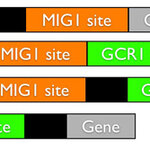Genetics & Molecular Biology

At a very early stage of human development, all cells of the embryo are identical, but unlike adult cells are very flexible and carry within them the potential to become any tissue type, whether it be muscle, skin, liver or brain.
This cell differentiation process begins at about the time that the embryo settles into the uterus. In terms of the inner workings of the cell, this involves two main control mechanisms. On the one hand, the genes that keep the embryo in their fully potent state are turned off, and at the same time, tissue-specific genes are turned on. By activating a certain…

Metaphors are dangerous things. On the one hand, it seems pretty much impossible to avoid using them, especially in rather abstract fields like philosophy and science. On the other hand, they are well known to trick one’s mind into taking the metaphor too literally, thereby creating problems that are not actually reflective of the reality of the natural world, but are only perverse constructs of our own warped understanding of it.
Take the metaphor of living organisms as analogous to complex artifacts, which led William Paley to articulate the most famous argument in favor of Intelligent…
Asymmetry is crucial for the heart proper functioning, and now, scientists from the Institute Gulbenkian of Science in Portugal and Harvard University, have discovered that a family of genes, called Nodal, is crucial determining this asymmetry by controlling the speed and direction of the heart muscle cells during embryonic development.
The finding, by helping to understand how the heart develops, is a step closer to intervention and is of particular importance if we consider that problems in heart asymmetry are the main cause of heart congenital diseases that can affect as much as 8 out of…

Can science journalism get any more embarrassingly bad?
"Real-time gene monitoring developed" says a headline over at physorg.com. The piece starts off with an insane hook that makes no sense whatsoever:
With GeneVision, military commanders could compare gene expression in victorious and defeated troops. Retailers could track genes related to craving as shoppers moved about a store. "The Bachelor" would enjoy yet one more secret advantage over his love-struck dates.
Then you get to the real discovery: monitoring gene expression in real time with Green Fluorescent Protein. This is news?…

The first demonstration that a single adult stem cell can self-renew in a mammal was reported at the American Society for Cell Biology (ASCB) 48th Annual Meeting, Dec. 13-17, 2008 in San Francisco. The transplanted adult stem cell and its differentiated descendants restored lost function to mice with hind limb muscle tissue damage.
The adult stem cells used in the study, conducted at Stanford University, were isolated from a mixed population of satellite cells in the skeletal muscle of mice. The skeletal adult muscle stem cells (MusSC), which live just under the membrane that…

Men determine the sex of a baby depending on whether their sperm is carrying an X or Y chromosome. An X chromosome combines with the mother's X chromosome to make a baby girl (XX) and a Y chromosome will combine with the mother's to make a boy (XY).
A Newcastle University study suggests that an as-yet undiscovered gene controls whether a man's sperm contains more X or more Y chromosomes, which affects the sex of his children. On a larger scale, the number of men with more X sperm compared to the number of men with more Y sperm affects the sex ratio of children born each year.
A gene consists…

It's the holiday season; a time when we are all supposed to get together with friends and family and enjoy ourselves. For people who feel left out, this is also a time to feel very lonely. Why do some people tend to feel more lonely than others?
John Cacioppo and William Patrick recently published a book entitled Loneliness: Human Nature and the Need for Social Connection. I read an article on CNN that reports the release of this book and discusses the components that cause variation in the feelings loneliness among individuals. Cacioppo is a…

Airline pilots who have flown for many years may be at risk of DNA damage from prolonged exposure to cosmic ionizing radiation, suggests a study in Occupational and Environmental Medicine.
The research team compared the rate of chromosomal (DNA) abnormalities in blood samples taken from 83 airline pilots and 50 university faculty members from the same US city.
The two groups were matched for age (35 to 56), sex (male), and smoking habit (light or non-smokers). Age and smoking are known risk factors for cumulative DNA damage.
Fifty eight of the pilots (70%) had served in the military, and they…

How can we share 98% of our DNA with a chimpanzee and still be so different? One of the biggest biological surprises found in our genomes is that chimps, mice, and even flies don't differ very much from us in either number or types of genes. What makes the many diverse animal groups different is not what genes they have; the secret is in how those genes are used.
Something similar takes place inside ourselves: nearly every one of our cells carries the exact same DNA, and yet some cells transmit electrical signals in the brain, while others break down toxic compounds in the liver. How do you…

A new genome-wide study examines genetic variants associated with nine metabolic traits and is the first to draw out novel variants from a population unselected for current disease. The traits are indicators for common disease such as cardiovascular disease, type 2 diabetes, blood pressure, inflammation and lipid levels.
Cohorts are followed throughout their lives, gathering lifelong information about their health: these data will help researchers to dissect the complex causes of common disease, whether genetic or environmental. The current study might indicate genetic variants that influence…